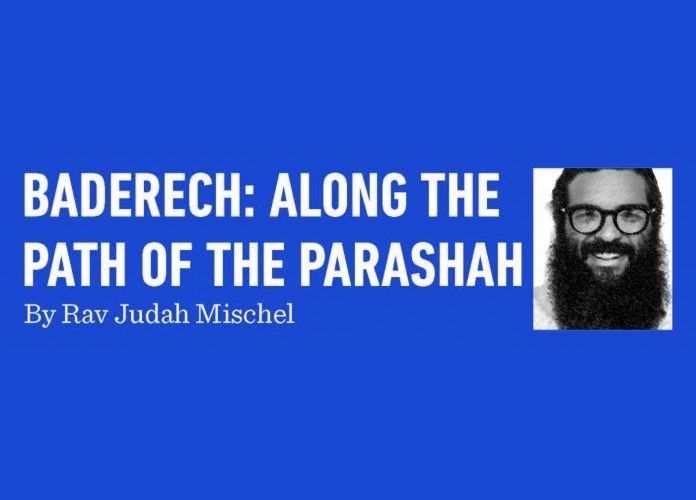Two Jews in a train station were waiting on the platform for their scheduled journey. A maskil stood reading the daily newspaper, while his fellow traveler, a chasidishe Yid, was engrossed in a sefer. The two exchanged respectful pleasantries and began to chat. “You haven’t looked up from your book for the whole while we have been here!” said the maskil. “What are you reading?”
“I’m learning Chumash, the Five Books of Moses.”
“Really, why? That’s thousands of years old! Too bad you waste so much time on things that have no relevance to what’s going on in the world. Here, take my newspaper, please. See this? There’s such a thing as current events, and politics, economics, fashion, the arts! This is what’s actually happening.”
“Ah, shkoyach, thank you,” sighed the chassid. “But why do you think I’m not up-to-date on what is happening? I’m maavir sedrah—I review the Torah portion each week, and so I’m completely current! What you’re reading in the news today will soon be old and stale, and tomorrow your paper will be used to wrap fresh fish. What I’m learning is eternally relevant and will always be current events!”
Shovavim is an acronym for the parshiyos of the Torah read during this period of six weeks: Shemos,Va’eira, Bo, Beshalach, Yisro, Mishpatim. This progression of parshiyos traces our development from a family of individuals to our becoming a nation. It begins with our descent into slavery, being mired in the depths of tumah in Mitzrayim, then being baderech to becoming a Nation, receiving the Torah, discovering our purpose, and manifesting as a free people.
Throughout Shovavim, we live the story of Klal Yisrael’s slavery by considering how we may have fallen into subtle servitude to our yetzer. It is a period of reflection and teshuvah, an opportunity to journey from our personal galus toward geulah. As Am Yisrael cries out, witnesses plagues, achieves freedom, and declares na’aseh v’nishma, entering a covenant with Hashem, we too cry out in prayer and prepare for liberation by opening ourselves to deeper levels of transformational Torah study and closeness with the Ribbono shel Olam.
The Gemara (Chagigah 15) relates the heartbreaking ma’aseh of “Acher,” Elisha ben Avuya, the teacher of the great Tanna, Rebbe Meir. Tragically, he lost his bearings and drifted far from observance—and from himself. As a result of his rebellion and fall from grace, Elisha ben Avuya became known as Acher, “the Other,” “the Alienated.”
Rebbe Meir pleaded with him and davened that he would return, but his mentor was so mired in despair and self-alienation that he began to think it was too late to do teshuvah. His brokenness led to self-delusion: When hearing a bas kol, a Heavenly voice, calling out the words of Yirmiyahu haNavi: “Shuvu banim shovavim, Return, My wayward children,” Acher believed that the voice concluded, “…chutz meAcher, except for Acher!” He had given up on himself and “decided” that he had gone too far, that the gates of tikun were closed.
The tzaddikim assure us that “Lo yidach mimenu nidach, No Jew is ever lost to Hashem’s People”—every Yid, regardless of how far one has strayed, is always welcome to come back. There is no such thing as “too late” or “too far.” Acher’s teshuvah would have been accepted if he had only had the humility, self-confidence, and faith in Hashem’s love to try.
Each day, that very bas kol emanates from Har Sinai, calling out to each of us, “Shuvu banim shovavim, Return, wayward children!” The Ribbono shel Olam, our beloved Father and benevolent King, is beckoning us to return, to start over again. This Divine call can be heard from within in the form of our own conscience, our inner voice summoning us, implicitly asserting that we will be welcomed back. Like a Divine “Wi-Fi signal,” during the weeks of Shovavim this bas kol connects us to the truth of who we are and empowers us to “log in” to our personal teshuvah process.
Through poignant contrast, the painful story of “Acher” hints that the Shovavim period invites us into fully restored connectivity specifically when we have made choices that distance us from holiness. During this unique and elevated time, we are encouraged to restore our spiritual health, strengthen our emunah in Hashem’s commitment to us as His children, and be welcomed into a life of deeper kedushah and exclusive loyalty to Hashem.
This weekend (24 Teves) marks the yahrzeit of Reb Shneur Zalman, the Ba’al haTanya, or “Alter Rebbe” of Lubavitch, zt’l. The Alter Rebbe declared that it is incumbent upon each of us to “live with the times” (Men b’darf leben mit der tzeit) and draw life and inspiration, guidance and insight, for our personal journey from the weekly sidrah—to live with the parashah. Our goal is to attach ourselves to the life force of the Torah that is being revealed each moment, and to live with the particular parashah of the day, in such a way that our inner world is shaped by the spiritual lessons, blessings, and challenges that unfold in the current narrative.
Shovavim is an eis ratzon, an opportune “time of favor” for us self-forgetful, “wayward” children to hear and answer the bas kol—to believe in our covenant and “family ties” with Hashem and one another. May we take advantage of this special time to reflect on the power of nishmas Yisrael, the collective soul of the Jewish People, and enjoy renewed health, happiness and revealed holiness and connectivity!
Rav Judah Mischel is executive director of Camp HASC, the Hebrew Academy for Special Children. He is the mashpia of OU-NCSY, founder of Tzama Nafshi, and the author of “Baderech: Along the Path of Teshuva.” Rav Judah lives in Ramat Beit Shemesh with his wife, Ora, and their family.














